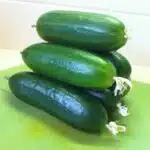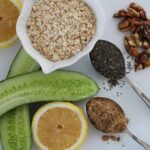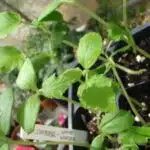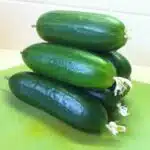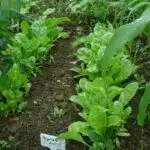Cucumbers, a member of the gourd family, are one of the most popular vegetables grown in home gardens. Growing cucumbers in container gardens is an excellent option for those with limited space or who want to add some greenery to their patios, balconies, or small yards. Container gardening offers gardeners the flexibility to control soil quality, moisture levels, and sunlight exposure.
When it comes to growing cucumbers in containers, there are several key factors that gardeners need to take into consideration. These include selecting the right type of container, choosing the appropriate soil mix and fertilizers, ensuring proper drainage and watering techniques, and providing adequate support for the plants as they grow. With proper care and attention, cucumber plants can thrive in containers and produce abundant yields of delicious fruits throughout the growing season.
Advantages Of Container Gardening For Cucumbers
Container gardening for cucumbers is an excellent way to grow fresh produce in limited space. There are various benefits of growing cucumbers in containers that make it a popular choice among gardeners. One significant benefit is the ease of access, especially for those with mobility issues. Container gardens can be placed at strategic locations, such as on porches or patios, making it easy to access and harvest cucumbers.
Another advantage of container gardening for cucumbers is flexibility. Unlike traditional gardening methods that require specific soil types, container gardens allow gardeners to control the soil mix used to grow their plants. This flexibility extends to the location where the containers are placed since they can be moved around to take advantage of optimal sunlight conditions or seasonal changes.
Despite its many benefits, container gardening has some limitations that gardeners should consider before embarking on this method. One limitation is the amount of water needed by plants grown in containers. Since containers have less soil volume than traditional gardens, they tend to dry out faster and require more frequent watering. Additionally, container-grown cucumbers may require more fertilizer than those grown in traditional gardens due to limited nutrient availability in the soil mix.
Moving on to selecting the right container for your cucumber plants, several factors must be considered before deciding on a pot size and type.
Selecting The Right Container For Your Cucumbers
Advantages of container gardening for cucumbers are many, from easy mobility and versatile placement options to avoiding soil-borne diseases. Container gardening allows gardeners to take full control of their growing environment, resulting in healthier plants and better yields. However, the benefits of container gardening are highly dependent on selecting the right container for your cucumbers.
Container material options range from terracotta and ceramic to plastic and fabric containers. Terracotta is a popular choice due to its classic look, but it is not ideal for cucumbers as it dries out quickly and can crack in cold temperatures. Plastic containers are durable and affordable, but they may become brittle over time under exposure to sunlight. Fabric containers are an excellent option as they provide better aeration while allowing excess water to drain easily.
The ideal container size for different cucumber varieties depends on their root system and growth habit. Dwarf or bush varieties require at least 5 gallons of soil per plant, while vining varieties need larger containers with a minimum capacity of 10-15 gallons per plant. The container’s depth should be at least 12 inches to accommodate the roots’ growth adequately. Moreover, ensure that the chosen container has ample drainage holes to prevent waterlogged soil that can lead to root rot.
Choosing the best soil mix for container cucumbers is crucial for healthy plant growth and maximum yields. The soil mix should be well-draining while being able to retain moisture adequately. A good recipe for cucumber container soil includes one-third peat moss or coconut coir, one-third compost or aged manure, and one-third vermiculite or perlite. Additionally, adding organic fertilizers such as bone meal or fish emulsion can provide essential nutrients throughout the growing season.
Moving forward into selecting the best soil mix for your cucumber container garden requires understanding how various soil components interact with each other in creating an optimal growing environment that fosters healthy plant growth, and we will delve into that in the next section.
Choosing The Best Soil Mix For Container Cucumbers
The first step to growing cucumbers in container gardens is choosing the right soil mix. The perfect soil mix for container cucumbers should be able to hold moisture and nutrients while allowing excess water to drain away. It should also have a pH level of 6-7, which is slightly acidic to neutral.
Soil pH is an important factor in determining the health and productivity of your cucumber plants. If the soil is too acidic or alkaline, plants may not be able to absorb essential nutrients, leading to stunted growth and poor yield. In addition, cucumbers have specific nutrient requirements that must be met for optimal growth. A soil mix that contains organic matter such as compost or aged manure can provide the necessary nutrients for healthy cucumber plants.
In summary, choosing the best soil mix for container cucumbers involves finding a balance between moisture retention and drainage, as well as maintaining a slightly acidic to neutral pH level. Additionally, providing adequate nutrients through organic matter can help meet cucumber’s specific nutrient requirements. Understanding these factors can help ensure healthy and productive cucumber plants in your container garden.
Transitioning into the subsequent section about understanding fertilizers for container cucumbers, it is important to note that while organic matter can provide some necessary nutrients, additional fertilization may still be required for optimal growth and yield.
Understanding Fertilizers For Container Cucumbers
When it comes to growing cucumbers in containers, fertilizing is a critical step towards achieving healthy and thriving plants. Understanding organic fertilizers and synthetic fertilizer options can help you make informed decisions on what type of fertilizer to use for your container cucumbers. Organic fertilizers are derived from natural sources such as compost, animal manure, and bone meal. They are slow-release fertilizers that provide long-term benefits to the soil by improving its structure, texture, and fertility.
On the other hand, synthetic fertilizers are manufactured using chemicals that provide quick-release nutrients to the plant. They are often cheaper and easier to apply compared to organic fertilizers but can have negative impacts on the environment if not used correctly. It is important to note that over-fertilization can harm your cucumber plants, so it is crucial to follow the recommended application rates for both organic and synthetic fertilizers.
Understanding the different types of fertilizers available for container cucumbers can help you make informed choices that will lead to healthy and productive plants. Whether you choose organic or synthetic options, remember that providing proper drainage for your cucumber containers is essential for their growth and development. In the next section, we will discuss how to ensure adequate drainage in your cucumber containers for optimal plant health.
Providing Proper Drainage For Your Cucumber Containers
Drainage is key when it comes to growing cucumbers in containers. Proper drainage ensures that excess water is removed from the container, allowing air to circulate and preventing root rot. Without proper drainage, your cucumber plant will not thrive, and you risk losing your harvest.
Importance of mulching: One way to improve the drainage of your cucumber container is by adding a layer of mulch on top of the soil. Mulch helps to retain moisture while also providing a layer of insulation between the soil and the outside environment. This insulation will help regulate the temperature inside the container, ensuring that your plants receive optimal growing conditions.
Tips for preventing over watering: Overwatering can be just as damaging as under-watering. To prevent over watering, choose a container with sufficient drainage holes and avoid placing saucers underneath. It’s important to monitor the moisture level of your soil regularly; if it feels moist one inch below the surface, then it doesn’t need watering yet.
Incorporating these tips will help you provide proper drainage for your cucumber containers. However, it’s important to remember that proper drainage is only one aspect of maintaining a healthy cucumber plant. In the following section, we will discuss different watering techniques that are essential for growing healthy and fruitful cucumbers in containers.
Watering Techniques For Container-Grown Cucumbers
Proper watering is vital in the successful growth of cucumbers, especially when grown in container gardens. Many gardeners often struggle with overwatering or underwatering their plants, leading to stunted growth and poor yields. To overcome these challenges, alternative watering methods can be employed to ensure that your cucumber plants remain healthy and productive.
One effective method is bottom watering, where water is poured into a tray beneath the container, allowing the soil to absorb it from below. This helps prevent waterlogging and encourages deeper root growth. Additionally, using a drip irrigation system can provide a steady supply of water directly to the plant roots without wetting the foliage excessively. This method saves time and effort while reducing water waste compared to traditional overhead watering techniques.
Overcoming watering challenges also involves understanding the specific needs of your cucumber plants at different stages of growth. During germination, maintain consistent moisture levels by misting regularly or covering with plastic wrap until seedlings emerge. As they grow, gradually increase watering frequency while avoiding oversaturation of soil that can lead to fungal diseases. Once fruit-bearing begins, keep soil consistently moist but not waterlogged to support healthy fruit development.
In summary, alternative watering methods such as bottom watering and drip irrigation can help overcome common challenges faced by container gardeners when growing cucumbers. Understanding your plant’s specific needs at different stages of growth will also aid in proper watering practices. In the next section, we will discuss creating a support system for your cucumber plants to promote healthy growth and yield.
Creating A Support System For Your Cucumber Plants
Proper watering is essential for the growth and development of cucumber plants in container gardens. However, it’s not the only factor that affects their success. Cucumbers are vigorous climbers and require a support system to keep them upright as they grow.
A DIY trellis design is an excellent option for supporting your cucumber plants. A trellis is easy to make and can be customized to fit your container size and plant needs. You can use materials like bamboo poles or wooden stakes to create a simple grid-like structure, or you can get creative with more intricate designs using wire mesh or even recycled materials like pallets.
If a traditional trellis doesn’t suit your aesthetic or space limitations, there are alternative support structures you can try. For example, you could use tomato cages or even repurpose old ladders as supports for your cucumbers. Just make sure whatever structure you choose can withstand the weight of your growing plants and won’t topple over in high winds.
As we’ve seen, creating a support system for your cucumber plants is crucial for their success in container gardens. With options ranging from simple DIY trellises to repurposed structures like tomato cages or ladders, there’s no shortage of ways to keep your cucumbers climbing upwards towards a bountiful harvest. In the next section, we’ll explore how choosing the best cucumber variety for containers can further enhance your gardening experience.
Choosing The Best Cucumber Variety For Containers
Finding the perfect cucumber variety to grow in a container garden can be as challenging as finding a needle in a haystack. With so many seed options available, it can be overwhelming to choose the right one. However, just like how a fashionista chooses the perfect dress, finding the ideal cucumber variety requires consideration of specific factors. Container size is an essential factor when selecting cucumber seeds. It is essential to note that cucumbers grow tall and need enough space to stretch out their roots. Therefore, it would help if you chose varieties that do not require extensive root systems.
Seed selection is another critical factor when choosing cucumber varieties for container gardening. The good news is that there are numerous seed options for container gardens. When making your choice, consider hybrid seeds that are disease-resistant and have a shorter growing season. Some excellent seed options include ‘Bush Pickle’ and ‘Spacemaster.’ These varieties are compact and perfect for smaller containers or balcony gardens.
In conclusion, choosing the best cucumber variety for containers requires careful consideration of several factors such as container size and seed selection. Hybrid seeds such as ‘Bush Pickle’ and ‘Spacemaster’ are excellent choices for container gardens due to their smaller sizes and disease resistance. By carefully selecting your cucumber varieties, you can guarantee an abundant harvest from your container garden. The next step is understanding cucumber planting and care to ensure maximum yield from your chosen variety.
Understanding Cucumber Planting And Care
Cucumbers are a popular addition to container gardens due to their versatility and ease of cultivation. For successful cucumber growth, it is important to choose the right container size and soil type. A container with a minimum depth of 12 inches and good drainage is recommended for optimum root development. The soil should be well-draining and rich in organic matter. Additionally, cucumbers require full sunlight exposure of at least six hours per day.
Cucumber pollination is an important aspect of growing healthy cucumbers. Cucumbers are pollinated by bees or by hand-pollination. Hand-pollination can be done by using a small brush or cotton swab to transfer pollen from male flowers to female flowers. It is also important to prune your cucumber plant regularly for optimum fruit production. Pruning techniques remove any damaged or diseased leaves that may affect the overall health of the plant. Pruning also helps control the size of the plant, which is particularly important when growing cucumbers in containers.
To ensure a bountiful harvest, managing pests and diseases in container cucumbers is crucial. Common cucumber pests include aphids, spider mites, and cucumber beetles while common diseases include powdery mildew and bacterial wilt. To prevent these problems, regular scouting of plants for signs of infestations should be conducted, along with proper sanitation practices such as removing any fallen leaves or debris from around the base of the plant. In addition, organic methods like neem oil or insecticidal soap can be used for pest management, while fungicides can help control diseases.
Transition: Now that we have discussed how to care for your cucumber plants let’s delve into more detail on how you can manage pests and disease in your container garden cucumbers without compromising their overall growth potential.
Managing Pests And Diseases In Container Cucumbers
Pests and diseases can be a major problem for container-grown cucumbers. One of the most common pests is the cucumber beetle, which can quickly destroy plants. To combat this, natural remedies such as neem oil or insecticidal soap can be used. These treatments are safe for both the plant and the environment.
Another way to manage pests and diseases is through companion planting. Some plants, like marigolds, have natural pest-repelling properties that can help protect your cucumber plants. Planting herbs like basil or dill near your cucumbers can also attract beneficial insects that will prey on common pests.
While prevention is key in managing pests and diseases, it’s important to monitor your plants regularly for any signs of trouble. Catching problems early on can often mean the difference between saving or losing a plant. With these natural remedies and companion planting techniques, you can keep your container-grown cucumbers healthy and thriving throughout the season.
Transition: Now that you’ve learned how to manage pests and diseases in your container garden, let’s move on to some harvesting tips for your freshly grown cucumbers.
Harvesting Tips For Container-Grown Cucumbers
As any gardener knows, managing pests and diseases can be a daunting task. But with container gardening, it becomes even more important to stay vigilant as the plants are in a more confined space. By regularly inspecting your cucumber plants and removing any diseased leaves or fruits, you can prevent the spread of disease and keep your cucumbers healthy.
However, it’s not just about preventing pests and diseases. Maximizing your yield is also crucial for successful container cucumber gardening. One way to do this is by proper timing – planting your cucumbers at the right time of year when temperatures are warm enough for growth but not too hot that they wilt. Additionally, regularly fertilizing your plants will help encourage healthy growth and increase fruit production.
Once you’ve harvested your cucumbers, the next step is preserving them for future use. Whether you choose to pickle them or store them fresh in the fridge, there are a few tips to keep in mind to ensure they last as long as possible. It’s important to wash them thoroughly before storing and try not to let them touch each other as this can cause bruising. With these tips in mind, you’ll be able to enjoy your home-grown cucumbers long after harvest season has ended.
Preserving Your Cucumber Harvest
Once you have harvested your cucumbers, there are several ways to preserve them for later use. Pickling is a popular technique that not only extends the shelf life of the cucumber but also brings out its unique flavor. To pickle cucumbers, you will need to prepare a brine solution made of vinegar, water, salt, sugar, and spices. You can experiment with different spice blends to create your unique pickling recipe.
If pickling isn’t your thing, there are plenty of creative cucumber recipes that you can try. Cucumbers are incredibly versatile and can be used in salads, sandwiches, smoothies, and even cocktails. For example, you can make a refreshing cucumber and mint salad or add sliced cucumbers to your favorite sandwich for an extra crunch. You can also blend cucumbers into a green smoothie or muddle them in a gin and tonic for a summery twist.
Preserving your cucumber harvest is an excellent way to enjoy fresh cucumbers all year long. Whether you prefer pickling or experimenting with creative recipes, there are many ways to make the most of your cucumber harvest. In the next section, we will explore how to save seeds from your cucumber plants so that you can continue growing fresh cucumbers season after season without having to purchase new seeds each year.
Saving Seeds From Your Cucumber Plants
Why save seeds from your cucumber plants? There are several benefits of seed saving, including ensuring the availability of a specific variety in future growing seasons, saving money on seed purchases, and fostering a deeper connection to the food we eat by understanding the lifecycle of plants. Additionally, saved seeds have already adapted to the local growing conditions and may be better suited for future harvests.
When it comes to successfully storing cucumber seeds, there are a few techniques to keep in mind. First, ensure that the seeds are completely dry before storing them in an airtight container in a cool and dark location. It is also important to label each container with the plant variety and date of storage. With proper storage techniques, cucumber seeds can last up to six years.
Overall, saving seeds from your cucumber plants can be a rewarding experience for any gardener. Not only does it allow for continued growth and success in future growing seasons but also encourages sustainable practices and preservation of heirloom varieties. In the next section, we will explore common issues that may arise when growing cucumbers in containers and how to troubleshoot them effectively.
Transitioning into our next topic, it is important to recognize potential challenges when growing cucumbers in container gardens. By being aware of common issues such as pest infestations or improper watering techniques, gardeners can take proactive steps towards addressing these problems before they escalate.
Troubleshooting Common Issues With Container Cucumbers
When it comes to growing cucumbers in containers, gardeners should be aware of several common issues that may arise. One such issue is pest prevention. Cucumber beetles are a common pest that can cause damage to the plant and reduce yield. To prevent this, gardeners can use row covers or insecticides specifically designed for cucumber beetles. Additionally, regular inspection of plants can help detect any early signs of infestation before it becomes more severe.
Another issue that container cucumber growers may face is nutrient deficiencies. Since container gardens have limited space and soil, nutrients can quickly become depleted. Gardeners should ensure they are using a high-quality potting mix with added nutrients and regularly fertilize the plants with a balanced fertilizer to avoid nutrient deficiencies. Signs of nutrient deficiency include yellowing leaves or stunted growth.
Overall, troubleshooting common issues when growing cucumbers in containers requires attention to detail and regular maintenance. By implementing proper pest prevention measures and ensuring adequate nutrient levels, gardeners can overcome many challenges associated with container gardening. In the next section, we will answer frequently asked questions about growing cucumbers in containers to provide additional support for those looking to cultivate their own crop.
Transition: Now that we have addressed some common issues faced by container cucumber growers, let’s move on to frequently asked questions about growing cucumbers in containers.
Frequently Asked Questions About Growing Cucumbers In Containers
Despite the common issues that come with growing cucumbers in containers, it is still a popular method for many gardeners. One of the biggest concerns is container size. It is important to choose a container that is large enough to accommodate the roots of the cucumber plant. A container that is too small can lead to stunted growth and reduced yields. The recommended minimum size for growing cucumbers in containers is 5 gallons, but larger containers are even better.
Another factor to consider when growing cucumbers in containers is the optimal planting time. Cucumbers thrive in warm soil, so it’s best to wait until after the last frost before transplanting seedlings into your container garden. This usually happens around late spring or early summer depending on your location. Keep in mind that cucumbers need at least 8 hours of sunlight per day, so choose a location that receives plenty of natural light.
Here are three frequently asked questions about growing cucumbers in containers:
- How often should I water my cucumber plants in containers? Cucumbers require consistent moisture, so check the soil daily and water as needed to keep it evenly moist.
- Can I grow multiple cucumber plants in one container? While it’s possible, it’s not recommended as each plant needs adequate space for root growth and air circulation.
- How do I know when my cucumbers are ready to harvest? Look for firm, dark green cucumbers that are about 6-8 inches long. Regularly harvesting ripe cucumbers will encourage more fruit production.
With proper planning and care, growing cucumbers in containers can be a rewarding experience for any home gardener. By choosing an appropriate container size and planting at the optimal time, you can ensure healthy growth and bountiful harvests from your cucumber plants.
Conclusion
Container gardening is a popular and practical way to grow cucumbers, especially for those who have limited outdoor space or live in urban areas. This method allows gardeners to control the environment in which the plants grow, ensuring optimal conditions for healthy growth and abundant harvests. By selecting the right container, soil mix, fertilizer, and drainage system, gardeners can successfully cultivate cucumbers in containers.
One theory suggests that container-grown cucumbers produce smaller fruits than those grown in traditional gardens. While this may be true for some varieties of cucumbers, it is not a universal truth. With proper care and attention to detail, container-grown cucumbers can produce fruits that are just as large and flavorful as those grown in the ground. In fact, container gardening can provide several benefits for cucumber plants, such as protection from pests and diseases and easier maintenance.
In conclusion, growing cucumbers in containers is a viable option for gardeners who want to enjoy fresh produce even with limited outdoor space or resources. By following the guidelines provided in this article – selecting appropriate containers, using high-quality soil mix and fertilizers, providing adequate drainage systems – gardeners can successfully cultivate healthy cucumber plants that yield bountiful harvests. While there may be some myths surrounding container gardening practices such as cucumber size reduction, these theories are not always true; thus it is important to investigate further information before believing them blindly. Container gardening offers an exciting opportunity for horticulture enthusiasts to explore new ways of cultivating their favorite crops while maximizing their yield potential.
Image Credits
- “Cucumber Harvest” by David Davies (featured)


